World War I Roll of Honour - The Clove Club Hackney Downs School
World War I Roll of Honour - The Clove Club Hackney Downs School
World War I Roll of Honour - The Clove Club Hackney Downs School
Create successful ePaper yourself
Turn your PDF publications into a flip-book with our unique Google optimized e-Paper software.
THE RETREAT FROM ANTWERP<br />
by<br />
ABLE-SEAMAN John F. Hopkins, R.N.V.R.<br />
Reprinted from “<strong>The</strong> Review”, No. 85, Summer, 1915.<br />
<strong>The</strong> article was published whilst Able Seaman Hopkins was interned in Holland.<br />
Two days after the declaration <strong>of</strong> war between England and Germany I joined the Royal Naval Volunteer<br />
Reserve (London Division). About the middle <strong>of</strong> August we went into camp at Walmer, where remained<br />
until Sunday, October 4th. “Reveillé” sounded at 5.30 that morning instead <strong>of</strong> at seven o’clock, as<br />
was usual on Sundays - and to put the matter in a few words, we were told to get under way for an<br />
unknown destination. Six hours later we marched out <strong>of</strong> camp. We reached Dover at 2.45 p.m., and<br />
marched straight on to the Admiralty Pier, where we hung about until ten o’clock, when our transport,<br />
S.S. “Mount Temple” (since sunk) came alongside. It was rumoured that she should have been<br />
alongside at 3 p.m., but, owing to the presence <strong>of</strong> German submarines in the vicinity, she was unable<br />
to do so. However, we commenced work immediately on ammunition, stores, etc., until 2.45 on<br />
Monday morning, and, a quarter <strong>of</strong> an hour later we got under way, escorted by two torpedo-boat<br />
destroyers.<br />
We arrived at Dunkirk next morning, and after waiting about for eleven hours, entrained for Antwerp,<br />
having each received a hundred rounds <strong>of</strong> ball cartridge. We reached Antwerp at four o’clock on<br />
Tuesday morning in the rain, and “falling in” on the platform, marched away to what had been a picture<br />
palace about six miles out. <strong>The</strong> roads were simply awful, as we found to our cost when on the retreat;<br />
they were made <strong>of</strong> huge cobble-stones, and not too well set at that. On this part <strong>of</strong> the march we<br />
crossed a beautiful square, with statues <strong>of</strong> marble in the centre. At this early hour crowds <strong>of</strong> people<br />
were already out, and treated us with great kindness, giving us cigarettes and tinned meat, shaking<br />
hands and crying out in broken English, “England for ever,” and “Long live the English king,” et<br />
cetera, and so forth, and so on. We soon after passed an archway <strong>of</strong> old stonework. This, we<br />
afterwards learned, was the boundary <strong>of</strong> the city. It was also supposed to be a fort! A fort!! It is a<br />
wonder that the wind did not blow it over.<br />
On arriving at the erstwhile picture palace we were told to get some rest, as we were going into the<br />
trenches that night; but at 11 a.m. we were roused and marched straight away. <strong>The</strong> firing could now<br />
be heard quite distinctly. We covered about ten miles and reached a place where the firing was very<br />
heavy, and here we made our ammunition up to 250 rounds apiece. But we were to be disappointed.<br />
Our marines were falling back, and we were too late to help them, so we tramped all the way back<br />
again and into another line <strong>of</strong> trenches, arriving there at three o’clock in the afternoon. We immediately<br />
set to to put on head-cover to the trenches, but at five o’clock we again marched <strong>of</strong>f to trenches seven<br />
miles further out in another direction, although we trudged from thirty to thirty-five miles to get there,<br />
taking all night until half-past four on Wednesday morning. <strong>The</strong> trenches were near to Mortsell, and<br />
we occupied them until 10 p.m. on Thursday, when our retreat began. <strong>The</strong> first shrapnel shell to find<br />
the trenches killed Lieut.Col. Maxwell and three men, and buried five others, all <strong>of</strong> whom were dug<br />
out alive. About 2.30 a.m. on Friday (October 9th) we crossed the Aviation Ground, and here a Belgian<br />
soldier, marching next to me, had his left leg taken <strong>of</strong>f by shrapnel.<br />
While we had been in the trenches the shells were flying over our heads into the city, and we could<br />
see the blaze from our entrenchment. To see the streets as we saw them the second time made one’s<br />
heart bleed. Yet there was something fascinating in the conflagration, the slaughter and the destruction.<br />
Now and then, as a shell found a billet in some unfortunate building, there would be a crash, and that<br />
building would be a heap <strong>of</strong> ruins. <strong>The</strong>n there were the Belgian-American Oil Company’s building<br />
and oil stores near to the Scheldt. Thousands <strong>of</strong> tons <strong>of</strong> oil were blazing hard, and the heat was<br />
frightful. At each end <strong>of</strong> the building floated the American flag; but what use was that? None. Ere<br />
we had left it ten minutes, the place crashed down in one vast, overwhelming conflagration.


